Abstract
Abstinence from chronic administration of various drugs of abuse such as ethanol, opiates, and psychostimulants results in withdrawal syndromes largely unique to each drug class. However, one symptom that appears common to these withdrawal syndromes in humans is a negative affective/motivational state. Prior work in rodents has shown that elevations in intracranial self-stimulation (ICSS) reward thresholds provide a quantitative index that serves as a model for the negative affective state during withdrawal from psychostimulants and opiates. The current study sought to determine whether ICSS threshold elevations also accompany abstinence from chronic ethanol exposure sufficient to induce physical dependence. Rats prepared with stimulating electrodes in the lateral hypothalamus were trained in a discrete-trial current-intensity ICSS threshold procedure; subsequently they were subjected to chronic ethanol administration in ethanol vapor chambers (average blood alcohol level of 197 mg/dl). A time-dependent elevation in ICSS thresholds was observed following removal from the ethanol, but not the control, chambers. Thresholds were significantly elevated for 48 hr after cessation of ethanol exposure, with peak elevations observed at 6-8 hr. Blood alcohol levels were directly correlated with the magnitude of peak threshold elevation. Ratings of traditional overt signs of withdrawal showed a similar time course of expression and resolution. The results suggest that decreased function of reward systems (elevations in reward thresholds) is a common element of withdrawal from chronic administration of several diverse classes of abused drugs.
Full text
PDF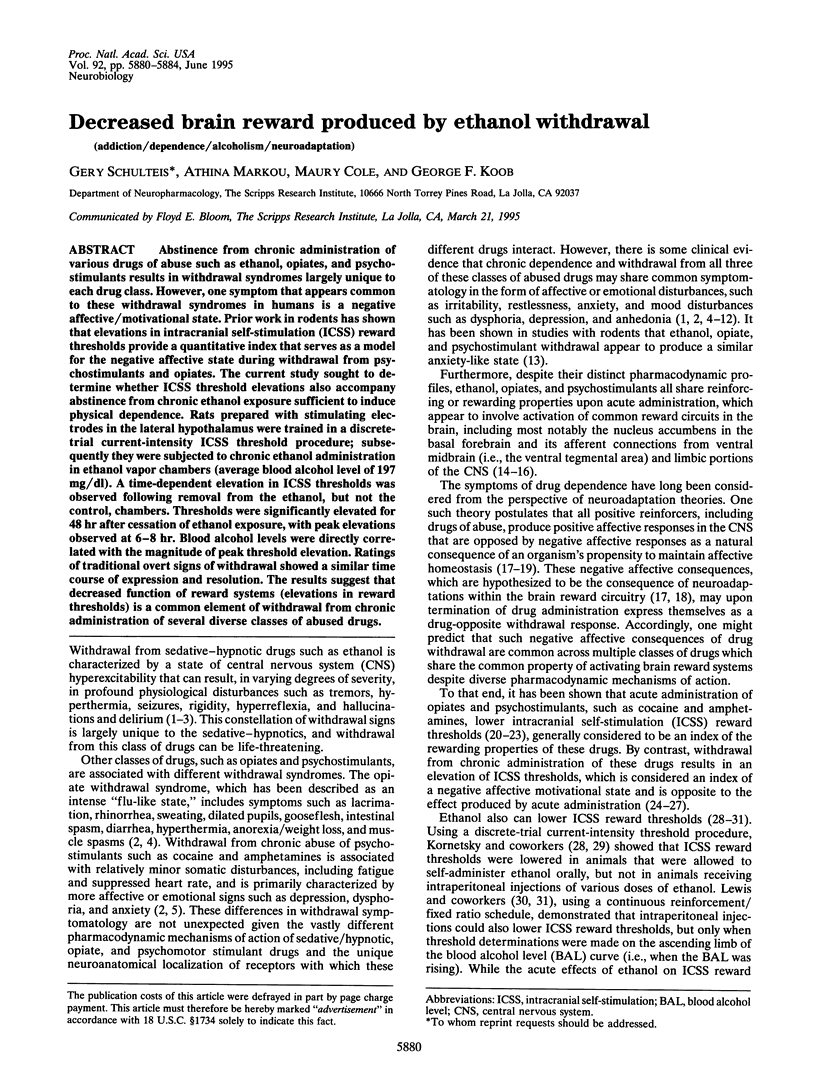
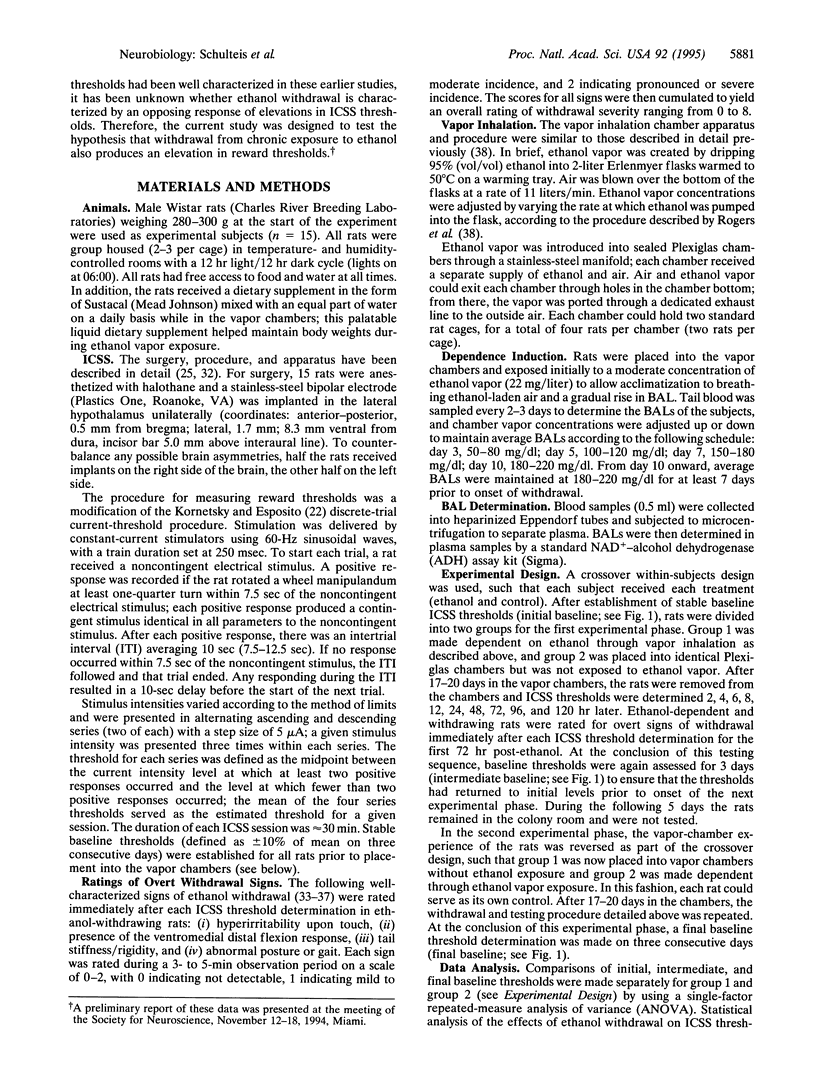
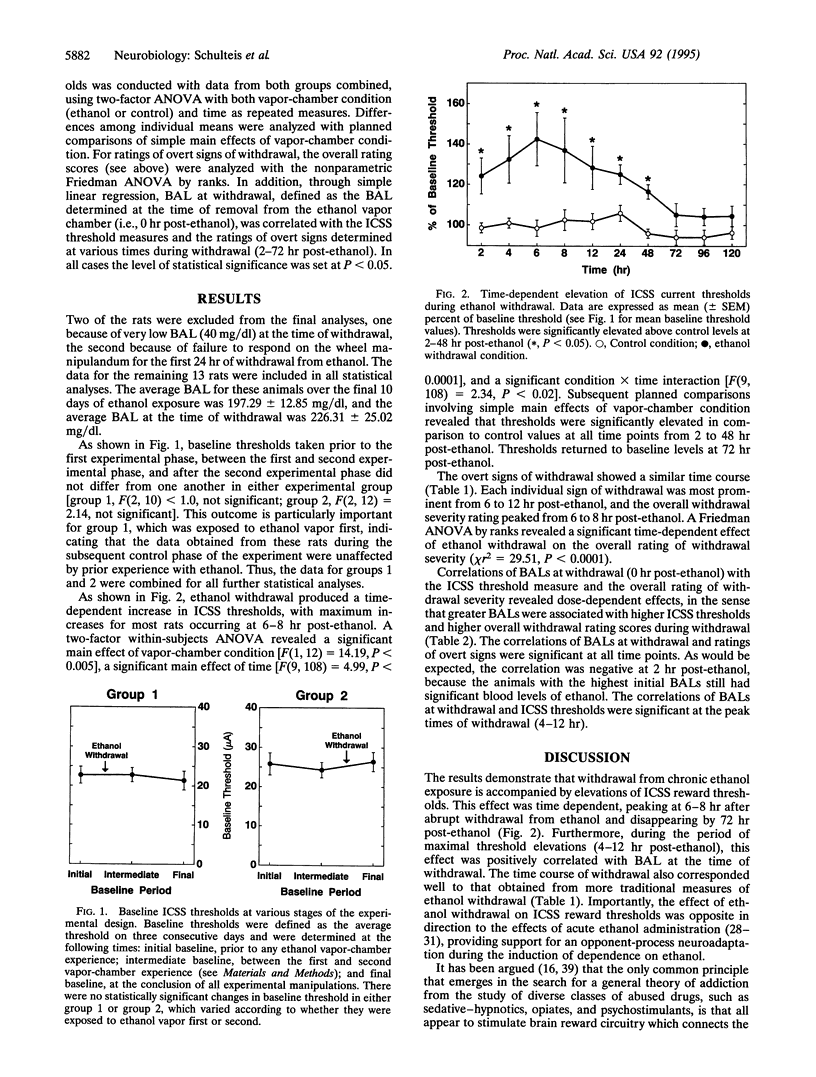
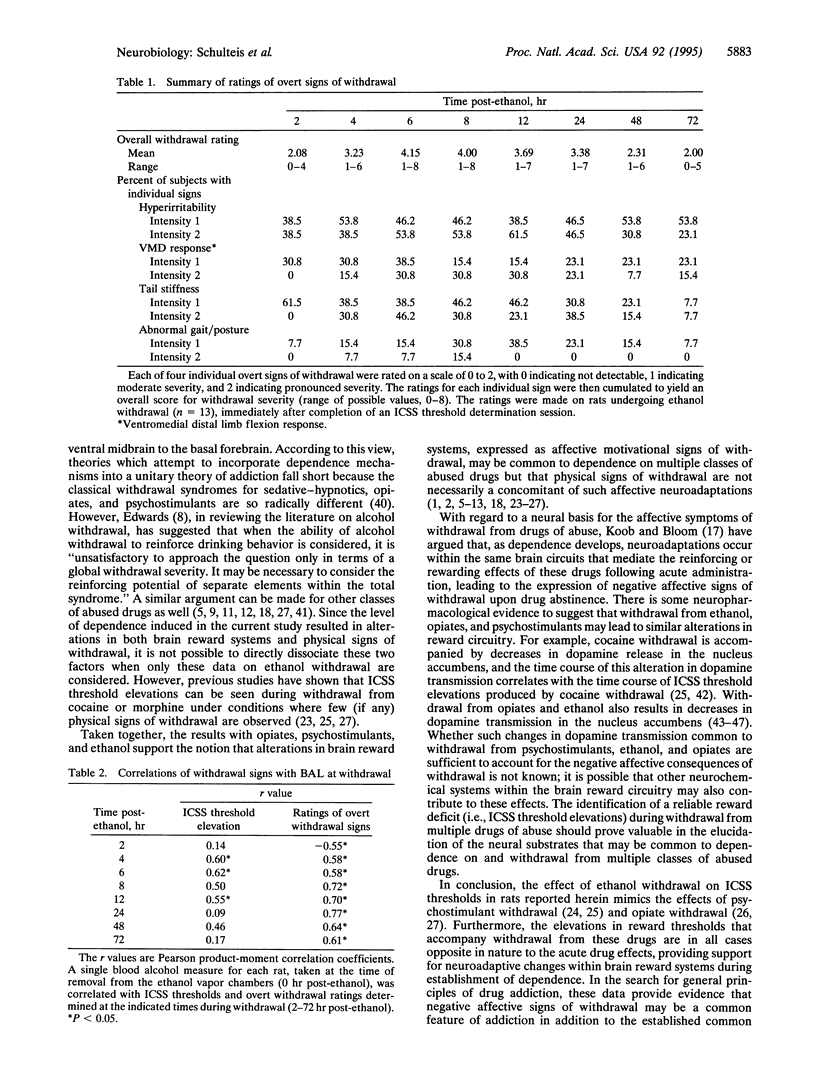
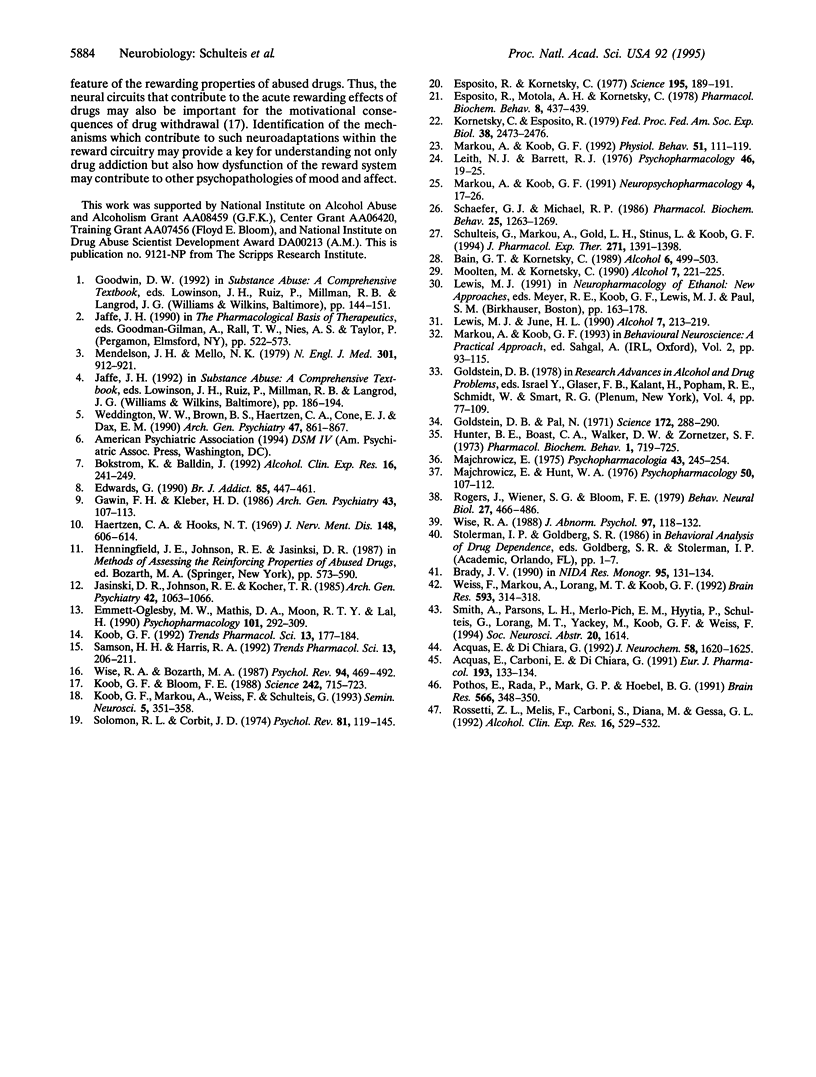
Selected References
These references are in PubMed. This may not be the complete list of references from this article.
- Acquas E., Carboni E., Di Chiara G. Profound depression of mesolimbic dopamine release after morphine withdrawal in dependent rats. Eur J Pharmacol. 1991 Jan 25;193(1):133–134. doi: 10.1016/0014-2999(91)90214-b. [DOI] [PubMed] [Google Scholar]
- Acquas E., Di Chiara G. Depression of mesolimbic dopamine transmission and sensitization to morphine during opiate abstinence. J Neurochem. 1992 May;58(5):1620–1625. doi: 10.1111/j.1471-4159.1992.tb10033.x. [DOI] [PubMed] [Google Scholar]
- Bain G. T., Kornetsky C. Ethanol oral self-administration and rewarding brain stimulation. Alcohol. 1989 Nov-Dec;6(6):499–503. doi: 10.1016/0741-8329(89)90058-x. [DOI] [PubMed] [Google Scholar]
- Bokström K., Balldin J. A rating scale for assessment of alcohol withdrawal psychopathology (AWIP). Alcohol Clin Exp Res. 1992 Apr;16(2):241–249. doi: 10.1111/j.1530-0277.1992.tb01370.x. [DOI] [PubMed] [Google Scholar]
- Brady J. V. Behavioral assessment of subtle drug abstinence effects: overview and discussion. NIDA Res Monogr. 1989;95:131–134. [PubMed] [Google Scholar]
- Edwards G. Withdrawal symptoms and alcohol dependence: fruitful mysteries. Br J Addict. 1990 Apr;85(4):447–461. doi: 10.1111/j.1360-0443.1990.tb01665.x. [DOI] [PubMed] [Google Scholar]
- Emmett-Oglesby M. W., Mathis D. A., Moon R. T., Lal H. Animal models of drug withdrawal symptoms. Psychopharmacology (Berl) 1990;101(3):292–309. doi: 10.1007/BF02244046. [DOI] [PubMed] [Google Scholar]
- Esposito R. U., Motola A. H., Kornetsky C. Cocaine: acute effects on reinforcement thresholds for self-stimulation behavior to the medial forebrain bundle. Pharmacol Biochem Behav. 1978 Apr;8(4):437–439. doi: 10.1016/0091-3057(78)90082-5. [DOI] [PubMed] [Google Scholar]
- Esposito R., Kornetsky C. Morphine lowering of self-stimulation thresholds: lack of tolerance with long-term administration. Science. 1977 Jan 14;195(4274):189–191. doi: 10.1126/science.831268. [DOI] [PubMed] [Google Scholar]
- Gawin F. H., Kleber H. D. Abstinence symptomatology and psychiatric diagnosis in cocaine abusers. Clinical observations. Arch Gen Psychiatry. 1986 Feb;43(2):107–113. doi: 10.1001/archpsyc.1986.01800020013003. [DOI] [PubMed] [Google Scholar]
- Goldstein D. B., Pal N. Alcohol dependence produced in mice by inhalation of ethanol: grading the withdrawal reaction. Science. 1971 Apr 16;172(3980):288–290. doi: 10.1126/science.172.3980.288. [DOI] [PubMed] [Google Scholar]
- Haertzen C. A., Hooks N. T., Jr Changes in personality and subjective experience associated with the chronic administration and withdrawal of opiates. J Nerv Ment Dis. 1969 Jun;148(6):606–614. doi: 10.1097/00005053-196906000-00004. [DOI] [PubMed] [Google Scholar]
- Hunter B. E., Boast C. A., Walker D. W., Zornetzer S. F. Alcohol withdrawal syndrome in rats: neural and behavioral correlates. Pharmacol Biochem Behav. 1973 Nov-Dec;1(6):719–725. doi: 10.1016/0091-3057(73)90036-1. [DOI] [PubMed] [Google Scholar]
- Jasinski D. R., Johnson R. E., Kocher T. R. Clonidine in morphine withdrawal. Differential effects on signs and symptoms. Arch Gen Psychiatry. 1985 Nov;42(11):1063–1066. doi: 10.1001/archpsyc.1985.01790340041006. [DOI] [PubMed] [Google Scholar]
- Koob G. F., Bloom F. E. Cellular and molecular mechanisms of drug dependence. Science. 1988 Nov 4;242(4879):715–723. doi: 10.1126/science.2903550. [DOI] [PubMed] [Google Scholar]
- Koob G. F. Drugs of abuse: anatomy, pharmacology and function of reward pathways. Trends Pharmacol Sci. 1992 May;13(5):177–184. doi: 10.1016/0165-6147(92)90060-j. [DOI] [PubMed] [Google Scholar]
- Kornetsky C., Esposito R. U. Euphorigenic drugs: effects on the reward pathways of the brain. Fed Proc. 1979 Oct;38(11):2473–2476. [PubMed] [Google Scholar]
- Leith N. J., Barrett R. J. Amphetamine and the reward system: evidence for tolerance and post-drug depression. Psychopharmacologia. 1976;46(1):19–25. doi: 10.1007/BF00421544. [DOI] [PubMed] [Google Scholar]
- Lewis M. J., June H. L. Neurobehavioral studies of ethanol reward and activation. Alcohol. 1990 May-Jun;7(3):213–219. doi: 10.1016/0741-8329(90)90007-y. [DOI] [PubMed] [Google Scholar]
- Majchrowicz E., Hunt W. A. Temporal relationship of the induction of tolerance and physical dependence after continuous intoxication with maximum tolerable doses of ethanol in rats. Psychopharmacology (Berl) 1976 Nov 10;50(2):107–112. doi: 10.1007/BF00430477. [DOI] [PubMed] [Google Scholar]
- Majchrowicz E. Induction of physical dependence upon ethanol and the associated behavioral changes in rats. Psychopharmacologia. 1975 Sep 17;43(3):245–254. doi: 10.1007/BF00429258. [DOI] [PubMed] [Google Scholar]
- Markou A., Koob G. F. Construct validity of a self-stimulation threshold paradigm: effects of reward and performance manipulations. Physiol Behav. 1992 Jan;51(1):111–119. doi: 10.1016/0031-9384(92)90211-j. [DOI] [PubMed] [Google Scholar]
- Markou A., Koob G. F. Postcocaine anhedonia. An animal model of cocaine withdrawal. Neuropsychopharmacology. 1991 Jan;4(1):17–26. [PubMed] [Google Scholar]
- Mendelson J. H., Mello N. K. Medical progress. Biologic concomitants of alcoholism. N Engl J Med. 1979 Oct 25;301(17):912–921. doi: 10.1056/NEJM197910253011704. [DOI] [PubMed] [Google Scholar]
- Moolten M., Kornetsky C. Oral self-administration of ethanol and not experimenter-administered ethanol facilitates rewarding electrical brain stimulation. Alcohol. 1990 May-Jun;7(3):221–225. doi: 10.1016/0741-8329(90)90008-z. [DOI] [PubMed] [Google Scholar]
- Pothos E., Rada P., Mark G. P., Hoebel B. G. Dopamine microdialysis in the nucleus accumbens during acute and chronic morphine, naloxone-precipitated withdrawal and clonidine treatment. Brain Res. 1991 Dec 6;566(1-2):348–350. doi: 10.1016/0006-8993(91)91724-f. [DOI] [PubMed] [Google Scholar]
- Rogers J., Wiener S. G., Bloom F. E. Long-term ethanol administration methods for rats: advantages of inhalation over intubation or liquid diets. Behav Neural Biol. 1979 Dec;27(4):466–486. doi: 10.1016/s0163-1047(79)92061-2. [DOI] [PubMed] [Google Scholar]
- Rossetti Z. L., Melis F., Carboni S., Diana M., Gessa G. L. Alcohol withdrawal in rats is associated with a marked fall in extraneuronal dopamine. Alcohol Clin Exp Res. 1992 Jun;16(3):529–532. doi: 10.1111/j.1530-0277.1992.tb01411.x. [DOI] [PubMed] [Google Scholar]
- Samson H. H., Harris R. A. Neurobiology of alcohol abuse. Trends Pharmacol Sci. 1992 May;13(5):206–211. doi: 10.1016/0165-6147(92)90065-e. [DOI] [PubMed] [Google Scholar]
- Schaefer G. J., Michael R. P. Changes in response rates and reinforcement thresholds for intracranial self-stimulation during morphine withdrawal. Pharmacol Biochem Behav. 1986 Dec;25(6):1263–1269. doi: 10.1016/0091-3057(86)90121-8. [DOI] [PubMed] [Google Scholar]
- Schulteis G., Markou A., Gold L. H., Stinus L., Koob G. F. Relative sensitivity to naloxone of multiple indices of opiate withdrawal: a quantitative dose-response analysis. J Pharmacol Exp Ther. 1994 Dec;271(3):1391–1398. [PubMed] [Google Scholar]
- Solomon R. L., Corbit J. D. An opponent-process theory of motivation. I. Temporal dynamics of affect. Psychol Rev. 1974 Mar;81(2):119–145. doi: 10.1037/h0036128. [DOI] [PubMed] [Google Scholar]
- Weddington W. W., Brown B. S., Haertzen C. A., Cone E. J., Dax E. M., Herning R. I., Michaelson B. S. Changes in mood, craving, and sleep during short-term abstinence reported by male cocaine addicts. A controlled, residential study. Arch Gen Psychiatry. 1990 Sep;47(9):861–868. doi: 10.1001/archpsyc.1990.01810210069010. [DOI] [PubMed] [Google Scholar]
- Weiss F., Markou A., Lorang M. T., Koob G. F. Basal extracellular dopamine levels in the nucleus accumbens are decreased during cocaine withdrawal after unlimited-access self-administration. Brain Res. 1992 Oct 16;593(2):314–318. doi: 10.1016/0006-8993(92)91327-b. [DOI] [PubMed] [Google Scholar]
- Wise R. A., Bozarth M. A. A psychomotor stimulant theory of addiction. Psychol Rev. 1987 Oct;94(4):469–492. [PubMed] [Google Scholar]
- Wise R. A. The neurobiology of craving: implications for the understanding and treatment of addiction. J Abnorm Psychol. 1988 May;97(2):118–132. doi: 10.1037//0021-843x.97.2.118. [DOI] [PubMed] [Google Scholar]


